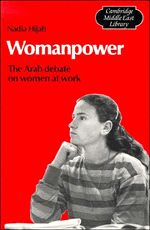Book contents
- Frontmatter
- Contents
- List of tables
- Preface
- List of abbreviations
- Introduction
- 1 The great family law debate
- 2 Cross-currents conservative and liberal
- 3 Arab women in the workforce
- 4 Jordanian women's liberating forces: inflation and labour migration
- 5 The Arab Gulf states: demand but no supply
- 6 Power past and future
- Bibliography
- Index
- Frontmatter
- Contents
- List of tables
- Preface
- List of abbreviations
- Introduction
- 1 The great family law debate
- 2 Cross-currents conservative and liberal
- 3 Arab women in the workforce
- 4 Jordanian women's liberating forces: inflation and labour migration
- 5 The Arab Gulf states: demand but no supply
- 6 Power past and future
- Bibliography
- Index
Summary
We must stop considering ourselves part of the world's folklore.
Lutfia al-Gabaili, Libyan editorIn the 1970s, Arab governments began to talk more frequently and more eloquently about the ‘need to integrate women in development’. Specialised departments were created, plans debated and women recruited. That was followed, in the 1980s, by a veritable eruption of interest at the popular level, reflected in the dozens of conferences and seminars held in the region and abroad on Arab women and their role in society.
This Arab awakening was part of a worldwide process that gained momentum when the United Nations declared 1975 International Women's Year. Indeed, two Arab countries, Egypt and Tunisia, were among the seven countries that introduced the resolution at the UN for a year to highlight women's issues. The Year became a Decade, its aim to achieve equality for women, and development and peace for the world by 1985.
The UN Decade for Women
It could not be said, by 1985, that the aims of the Decade had been achieved, in the Arab world or anywhere else. This was admitted in the documents presented during the End-of-Decade conference in Nairobi in 1985. In spite of some progress, the UN described the overall achievement as ‘modest’ (UN, 1985d, p.22). It identified the obstacles that continued to block the advancement of women around the world as: deeply rooted traditions; poor understanding of the significance of women's issues; and lack of financial resources to reform the position of women (UN, 1984b, pp.21–2).
- Type
- Chapter
- Information
- WomanpowerThe Arab Debate on Women at Work, pp. 1 - 8Publisher: Cambridge University PressPrint publication year: 1988

